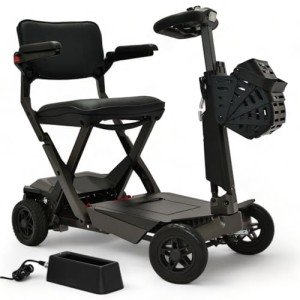The 10 Scariest Things About Mobility Scooters
Navigating the World of Mobility Scooters: A Comprehensive Guide
In an age where mobility is progressively acknowledged as a basic element of quality of life, the need for assistive gadgets has actually risen. Amongst these, mobility scooters stand apart as a versatile and empowering alternative for individuals with mobility obstacles. This comprehensive guide explores the world of mobility scooters, providing insights into their types, benefits, purchasing factors to consider, and upkeep tips.
Comprehending Mobility Scooters
Mobility scooters are motorized lorries designed to assist people with mobility issues in moving around more freely and independently. They are particularly advantageous for those who discover walking challenging due to conditions such as arthritis, numerous sclerosis, or post-surgical recovery. Unlike manual wheelchairs, mobility scooters need very little physical effort, making them an outstanding choice for extended usage.
Types of Mobility Scooters
Three-Wheel Scooters
- Pros: More maneuverable, lighter, and much easier to keep.
- Cons: Less stable on rough surface.
- Best For: Indoor and smooth outdoor surfaces.
Four-Wheel Scooters
- Pros: More stable, better on rough terrain, and can bring heavier loads.
- Cons: Bulkier and less maneuverable.
- Best For: Outdoor use, especially in parks and on irregular surfaces.
Portable Scooters
- Pros: Lightweight, collapsible, and simple to transportation.
- Cons: Limited range and speed.
- Best For: Travel and periodic use.
Durable Scooters
- Pros: Built to manage much heavier users and rugged environments.
- Cons: More pricey and less portable.
- Best For: Users over 300 pounds or those who need to navigate rough surface.
Standing Scooters
- Pros: Provide a standing position, which can be advantageous for users who can not sit for long durations.
- Cons: Limited stability and range.
- Best For: Users who prefer standing and require short-distance support.
Advantages of Mobility Scooters
Enhanced Independence
- Mobility scooters permit users to take a trip longer ranges without tiredness, allowing them to take part more fully in everyday activities and gatherings.
Improved Safety
- With features like safety belt, anti-tip wheels, and brake systems, mobility scooters provide a safer alternative to manual wheelchairs and strolling help.
Comfort and Support
- Adjustable seats, back-rests, and armrests guarantee a comfortable ride, minimizing the pressure on the user's body.
Economical
- While the preliminary investment can be substantial, mobility scooters are often more cost-efficient in the long run compared to frequent taxi rides or specialized transportation services.
Social Inclusion
- Mobility scooters help with greater social interaction by enabling users to take part in neighborhood activities and maintain a more active lifestyle.
Factors to Consider When Buying a Mobility Scooter
User Needs and Abilities
- Evaluate the user's physical condition, mobility needs, and day-to-day activities to identify the most appropriate type of scooter.
Size and Weight Capacity
- Make sure the scooter can accommodate the user's size and weight easily and securely.
Range and Speed
- Think about the common range and speed needed for daily usage. Some scooters have a series of approximately 30 miles on a single charge.
Portability
- If travel is a top priority, choose a portable scooter that can be quickly disassembled and transferred.
Maintenance and Support
- Choose a reputable producer that offers dependable consumer service and maintenance assistance.
Budget plan
- Set a spending plan and explore options that use the best value for cash. Think about financing options and potential insurance coverage.
Maintenance Tips for Mobility Scooters
Routine Cleaning
- Clean the scooter routinely to prevent dirt and debris from affecting its efficiency. Utilize a soft fabric and moderate detergent.
Battery Maintenance
- Follow the manufacturer's guidelines for battery charging and upkeep. Regularly check the battery level and prevent deep discharges.
Tire Inspection
- Inspect the tires for wear and correct inflation. mobility scooter stores or fix as required to make sure a smooth and safe ride.
Lubrication
- Lubricate moving parts such as the chain and equipments to minimize friction and avoid wear.
Expert Servicing
- Arrange routine expert servicing to attend to any problems and guarantee the scooter stays in optimal condition.
Frequently Asked Questions About Mobility Scooters
Are mobility scooters covered by insurance coverage?
- Some insurance plans, including Medicare, may cover the cost of mobility scooters under particular conditions. Examine with your service provider for particular information.
Can I utilize a mobility scooter inside?
- Yes, numerous mobility scooters are developed for both indoor and outside usage. Guarantee the scooter is ideal for the type of surface areas you will be browsing.
How quick can mobility scooters go?
- The speed differs by design, but the majority of mobility scooters have an optimal speed of 4 to 8 miles per hour.
Do I require a license to run a mobility scooter?
- In a lot of nations, a license is not required to run a mobility scooter. Nevertheless, it is essential to follow regional guidelines and traffic laws.
Can I travel with a mobility scooter?
- Numerous mobility scooters are designed to be portable and can be disassembled for travel. Contact airlines and transport suppliers for particular requirements.
Mobility scooters are a transformative tool for individuals with mobility obstacles, using a mix of independence, safety, and convenience. By understanding the various kinds of scooters, thinking about essential getting elements, and following upkeep best practices, users can take advantage of their mobility scooter and lead a more active and fulfilling life. Whether for day-to-day commutes or leisurely trips, a well-chosen mobility scooter can be a valuable companion on the journey to enhanced mobility and lifestyle.
